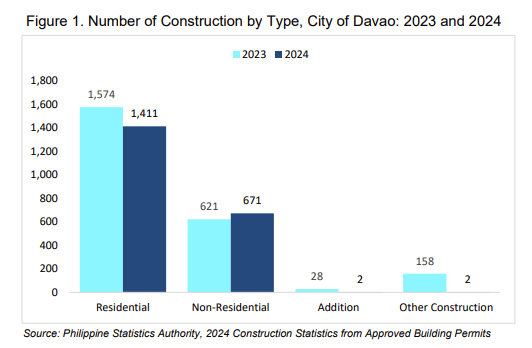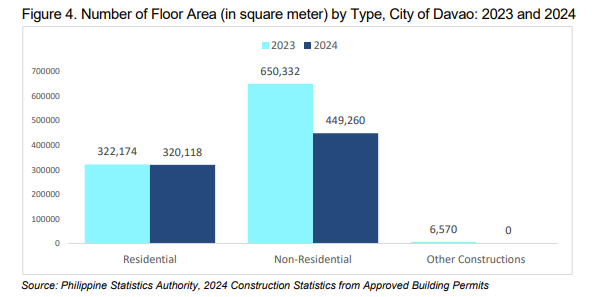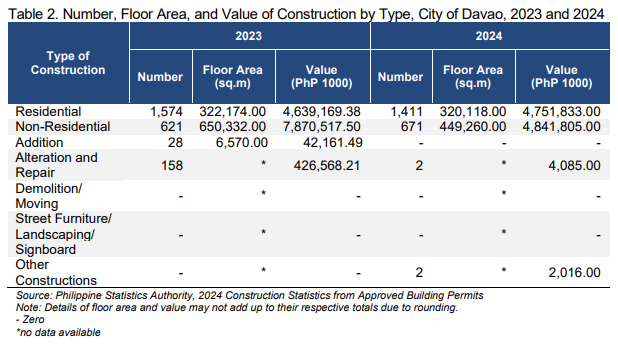
Total number of constructions from approved building permits declines by 12.4 percent
The total number of constructions from approved building permits in Davao City declined by 12.4 percent, with 2,086 constructions recorded in 2024 from 2,381 constructions in 2023.
By type of construction, residential buildings recorded the highest number of approved constructions at 1,411. It was a 10.4 percent decrease in the total number of constructions compared to 1,574 in 2023. This was followed by the non-residential buildings with 671 constructions, this was an 8.1 percentage increase from 621 constructions in the previous year. Construction activities involving building additions had a significant decline of 92.9 percent, with only 2 projects recorded in 2024 compared to 28 projects in 2023. Similarly, other types of construction such as alterations and repairs, demolition or moving, and street furniture, landscaping, or signboard installations declined by 98.7 percent, with 2 in 2024 from 158 in 2023.

All residential constructions are single-type houses
In 2024, all recorded residential construction from approved building permits were single-type houses. This had a total number of 1,411, reflecting a 10.83 percent decrease from the 2023 level of 1,573 residential construction buildings. On the other hand, other residential construction types, such as duplex/quadruplex, apartment accessories/accessoria, residential condominium, and other residential construction had no recorded data. (Figure 2).

Majority of non-residential construction are commercial type
Similarly, majority of non-residential constructions in 2024 were of the commercial type 555 approved projects. This represented a 12.3 percent increase from the 494 commercial buildings recorded in 2023. Followed by institutional buildings with 96 constructions, marking an 11.1 percent decrease from 108 recorded in 2023.
Furthermore, industrial buildings declined from 11 projects approved in 2024, reduced from 16 projects in 2023. Agricultural accounted for 8 approved constructions, while other non-residential buildings recorded a single project in 2024.

Commercial buildings record the highest value of constructions
The total value of constructions amounted to PhP9.60 billion, reflecting an annual decline of 27.0 percent from the PhP13.15 billion value of constructions in 2023.
Residential building constructions valued PhP4.75 billion. This indicated an annual increase of 2.4 percent from the PhP4.64 billion construction value of residential buildings recorded in 2023. On the other hand, the construction value of non-residential buildings amounted to PhP4.84 billion or 50.4 percent of the total construction value. This reflected a decrease of 38.5 percent from the PhP7.87 billion value of construction of non-residential buildings reported in the previous year (Table 1).

Total floor area of construction declines to 20.8 percent
The total floor area of constructions recorded at 769,378 square meters. This showed an annual decline of 20.8 percent from 972,506 square meters floor area in 2023.
Non-residential constructions recorded 449,260 square meters or 58.4 percent of the total floor area. It increased at an annual rate of 40.3 percent from 320,118 square meters of the previous year. Meanwhile, residential constructions recorded 320,118 square meters, reflecting a 41.6 percent of the total floor area of constructions, indicating an annual decline of 0.6 percent from the floor area of residential constructions in 2023 at 322,174 square meters (Figure 4).


Construction of non-residential buildings has the highest average cost
The average cost of construction in Davao City was recorded at PhP12, 467.58 per square meter. This was 3.1 percent lower than the average cost of PhP12,866.06 per square meter in 2023 (Table 3). Alteration and repair, demolition/moving, street furniture/landscaping/signboard were excluded in the average cost of construction since there is no reported floor area of these types of construction (Table 2).
By type of construction, non-residential buildings were the highest average cost of PhP7,182.99 per square meter. This was followed by a residential building with PhPb14,844.00 per square meter. On the other hand, addition to existing construction there was no recorded data in 2024.
Among residential construction, only single-type houses have recorded values. The average cost per square meter for single houses increased by 4.2 percent from its value of PhP14,249.01 in 2023 to PhP14,844.00 in 2024. Furthermore, across non-residential constructions, commercial buildings reported the highest cost, which amounted to PhP11, b 537.72 per square meter, indicating a 12.1 percent decrease from PhP13,b128.95 in the previous year (Table 3).
Technical Notes
The definition of term is adopted from the Revised and Updated Implementing Rules and Regulations of the National Building Code.
Building Permit is a written authorization granted by the LBO to an applicant allowing him to proceed with the construction of specific project plans after plans, specifications, and other pertinent documents have been found to be in conformity with the National Building Code.
Building refers to any independent, free-standing structure comprised of one or more rooms or other spaces, covered by a roof and enclosed with external walls or dividing walls, which extend from the foundation to the roof.
Construction refers to all on-site work done from site preparation, excavation, foundation, assembly of all the components and installation of utilities, machineries, and equipment of buildings/structures.
Residential building is a building for which its major parts or more than half of its gross floor area is built for dwelling purposes. This type of building can be of the single type, duplex, apartment and/or accessoria, and residential condominium.
- Single house is a complete structure intended for a single family or household, i.e., bungalows, 2-storey house, nipa hut, etc.
- Duplex house is a structure intended for two households, with complete living facilities for each; it is a single structure divided into two dwelling units by a wall extending from the floor to the ceiling.
- Apartment is a structure, usually of two storeys, made up of independent living quarters, with independent entrances from internal walls and courts.
- Accesoria is a one or two-floor structure divided into several dwelling units, each dwelling unit having its own separate entrance from the outside.
- Residential condominium is a structure, usually of several storeys, consisting of multiple dwelling units.
- Other residential construction consists of school or company staff houses, living quarters for drivers and maids, and guardhouses.
Non-residential buildings include commercial, industrial, agricultural, and institutional buildings.
- Commercial buildings refer to office buildings and all buildings which are intended for use primarily in wholesale, retail, and service trades, i.e., stores, hotels, restaurants, banks, disco houses, etc.
- Industrial buildings are buildings used to house the production, assembly, and warehousing activities of industrial establishments, i.e., factories, plants, mills, repair shops, machine shops, printing press, storage plants, electric generating plants.
- Institutional buildings are buildings which are primarily engaged in providing educational instructions and hospital/health care, ports, airports and other government buildings, i.e., schools, museums, libraries, sanitaria, churches, hospitals.
- Agricultural buildings are buildings used to house livestock, plants, and agricultural products such as barns, poultry houses, piggeries, stables, greenhouses, and grain mills.
- Other non-building constructions include cemetery structures, street furniture, waiting sheds, communication towers, etc.
Repair is a remedial work done on any damaged or deteriorated portion/s of a building/structure to restore its original condition.
Renovation is any physical change made on structures to increase their value and quality.
Alteration is a construction in a building/structure involving changes in the materials used, partitioning and location/size of openings, structural parts, existing utilities, and equipment but does not increase the overall area thereof.
Conversion is a change in the use or occupancy of structure or any portion thereof, which has different requirements.
Demolitions refer to the systematic dismantling or destruction of a building/structure, in whole or in part.
Street furniture are street structures consisting of monuments, waiting sheds, benches, plant boxes, lampposts, electric poles, and telephone poles.
Floor area of building refers to the sum of the area of each floor of the building measured to the outer surface of the outer walls including the area of lobbies, cellars, elevator shafts, and all communal spaces in multi-dwellings. Areas of balconies are excluded.
Total value of construction refers to the sum of the cost of building, electrical, mechanical, plumbing, and others. The value is derived from the approved building permit and represents the estimated value of the building or structure when completed.
Approved for Release:
ADELINE G. BATUCAN
(Supervising Statistical Specialist)
Officer-In-Charge
Davao del Sur Provincial Statistical Office
